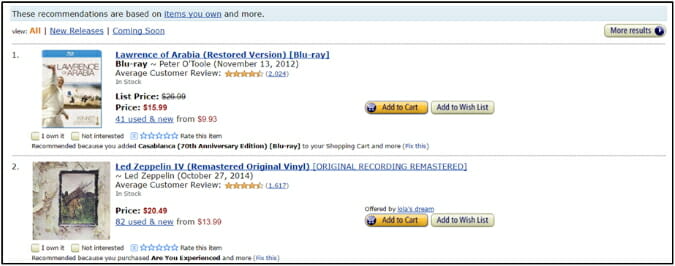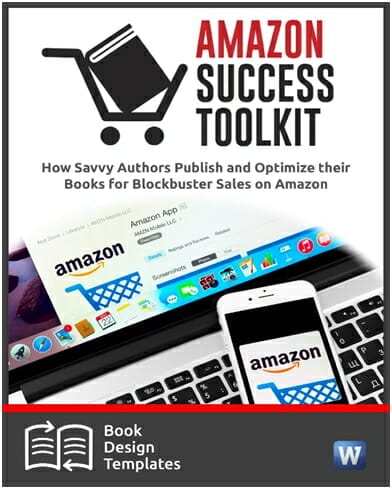By Tracy Atkins
In my article last month, Amazon is a Search Engine–Make Your Book an Easy-to-Find Product, I explained that the first concept is to think about Amazon as a search engine, instead of a retail store. Today, I will be discussing the second concept and why you should think of Amazon as a data gathering and filtering tool.
Amazon is a sophisticated and intelligent software system that not only stores a large catalog of products that users can search for, but also stores a lot of sales and buyer preference information, too. Like some fictional electronic big-brother, Amazon watches what you do and records it so that it can find ways to recommend a product that you might want to buy. It does its job really well and is getting smarter with each upgrade.
So, what does Amazon watch you might ask? It collects data from a number of points to build a profile of your individual habits and preferences. It collects data on:
- things you have browsed in the past
- products that have caught your interest
- things you have purchased
- the types of products you have purchased
- the videos you have watched on prime
- the books you are borrowed on your Kindle
The list goes on and on.
When you use Amazon, it is always taking notes and trying to figure you out in a logical way. That’s why your recommendations often catch your eye and you end up buying something you didn’t even know you needed, or why that lonely night of looking at books on buying your dream yacht keeps coming back to haunt your recommendation list over and over again. (Yes, we all have those things pop up on our list that make us scratch our head.)
It is all put together into a cumulative history that is used by Amazon to effectively recommend products, and you can use that to your advantage.
Collaborative Filtering, Algorithms and You
As stated in Concept One, everything on Amazon is driven by data and algorithms. Though you have control over things like book titles and keywords, other things like purchase history, reviews and what other people buy, and buy together, are not usually under your control.
All of these uncontrollable things fall under what is known as Collaborative Filtering. Collaborative filtering simply put, uses the specific purchases and tastes of individuals, and compares them to other people that are similar. The system tries to find commonality among the group to find the most desirable products for that group, or most desirable product pairings with the highest likelihood of being purchased together. That way, if someone is viewing a particular book, the system assesses other books (or products) that are good pairings and also recommends them to the customer.

These recommendation selections were based on movies and albums I recently purchased, (Ironically enough, I bought the first item listed here from Amazon already quite some time ago.So it’s not infallable.)
Because every person’s profile is different, and the pairings are constantly changing, it’s difficult to try to game the system in any way, (and you really shouldn’t try to do anything to game it.) But you can use some customer direction and marketing techniques to help get some visibility.
Because of collaborative filtering, Amazon often uses shopping history for items that people buy together, either at the same time, or over time, to make recommendations. That is important for authors who want to have their book show up in recommendation lists, as well as in the important “Also Bought” section of every Amazon product page. Working with this in mind will require a different mindset for marketing your book. We will cover that in a moment, but first, a little primer on Sales Rank.
Book Sales Rank Data
Amazon loves to rank books, and it does so constantly, re-ranking books every hour. Though tracking your book’s position in its category may seem like simple vanity, it is actually a very important component of how Amazon’s algorithms recommend your book to other people and therefore is a major component of collaborative filtering. (Otherwise, why else would Amazon spend so much computing power to calculate and re-rank millions of books every hour?)

Here is the Amazon Sales Rank data for the hot-selling book series Code Breakers, by Colin F. Barnes.
In the example above, you can see that this four book series, sold together as a set, and on-sale for $0.99 at the time, is killing it on Amazon (there really isn’t a better way to put that), in all of its categories. It will probably continue to do so based on the momentum of sales, its current sales rank, and the quality of the “also bought” books listed with it.
Like a snowball rolling down a mountain and growing, the higher a book’s sales rank is, the more visible it is, the more it is purchased with other books, and the more momentum it keeps up. And it will do that until either:
- the marketing and promotion for the book ends
- everyone that really wants to read it has bought it
- or the hourly sales volume slows down causing it to drop in rank
It’s a viral effect where success begets success, and maybe even creates a bestseller.
Pro Tip: Free books, those promoted through Amazon Kindle Select for “free days”, have a separate sales rank, just to keep things fair.
Now, you may draw an inference that the book above has a high sales rank because it is on sale for less than a dollar. The answer to that is both no and yes.
The price of a book on Amazon has no effect on sales rank, and little if any effect in how Amazon recommends products–unless they are a Kindle Select promotion. What the price does do, especially if it is a discounted price, is offer an incentive to buy, or put pressure on the customer to make the purchase. With that pressure more people buy the book during the same period of time, and therefore the sales rank goes up. There isn’t some magical trick here, just plain old supply and demand economics.
To Win, Direct Your Marketing Efforts Back to Amazon
With this in mind, as an author, you should focus on selling your book to your target or niche audience to increase the chances of a purchase along with other books in your category.
Since readers often stick to the same genre or niche for fiction, or buy more than one book in a nonfiction category, marketing to tight niches and categories maximize your chances of customers buying your book along with a similar title.
As this happens, your book will start to be seen as a viable pair with those books, increasing visibility yet again. Eventually, by continued efforts, your book may enter a cycle of being a top seller, and a top pairing with other products, which can be very profitable.
Another thing you can do is always point people to purchase the book from Amazon, so that the bulk, if not all sales, of your book is cataloged in Amazon, increasing your relevance. Every sale on Amazon boosts your sales rank in your niche category, and increases your chance of a purchased-together sale, too.
Pro Tip: You can even go so far as to offer your book bundled with others in your niche that are popular, perhaps with a coupon or gift-certificate offer as an incentive to buy them together to increase your collaborative filtering standing. Of course, this can be costly, and should be considered as part of an advertising budget.
To get the most success, you often need a boost, or kick, to get your sales rank up high enough to make your book visible to the most people possible. That is why taking a “big bang” approach to marketing your book to your niche can be very effective.
Though in all book promotion, steady and repetitive marketing is critical to long-term success, to get the book up in rank and visible, you need to have brief periods of hard-hitting promotion. If you can entice a thousand or so sales, often far less in focused niches, to buy your book in a day, you might just kick-start something viral that will lead to the “snowball effect”. That is what every author really wants to see, their book takeoff like a rocket, and with a little bit of effort, and a solid marketing budget, you can achieve just that.
Pro Tip: Your book’s launch is a great time to do this hard-hitting promotion. Our Book Launch Toolkit can help you out here.
Optimize Your Metadata for Your Niche
Finally, you can and should optimize the metadata that is under your control so that when people search for books that are similar and sell well, your books shows up on the list, too. It’s all relative, and by focusing your efforts on tighter audiences that are within your niche, your overall payoff can be greatly increased.
The main takeaway with your customers is summed up in the idiom; “birds of a feather, flock together.” Keep your efforts within your flock because Amazon does.
Concept Two Key Takeaways
- Amazon collects an incredible amount of data and uses it to recommend products to its customers.
- Collaborative Filtering builds product recommendations based on what is purchased together and the individual tastes of the customers.
- Also-bought are important, where popular combinations are bought together. Promote your book with similar top-selling books when possible.
- Try to focus your marketing efforts on your niche or group to maximize your exposure and chances of your book being purchased with other relevant books.
- Amazon likes to rank hot products so that they show up more often. This prevents books that have a momentary spike in sales from staying in the top, and a rolling average system that promotes consistently good performers.
This is just a sample of the great information you can find in the complete toolkit, and the full Amazon Success Method presented in the kit.
Click here to read more articles by Tracy Atkins.
Photo: BigStockPhoto



